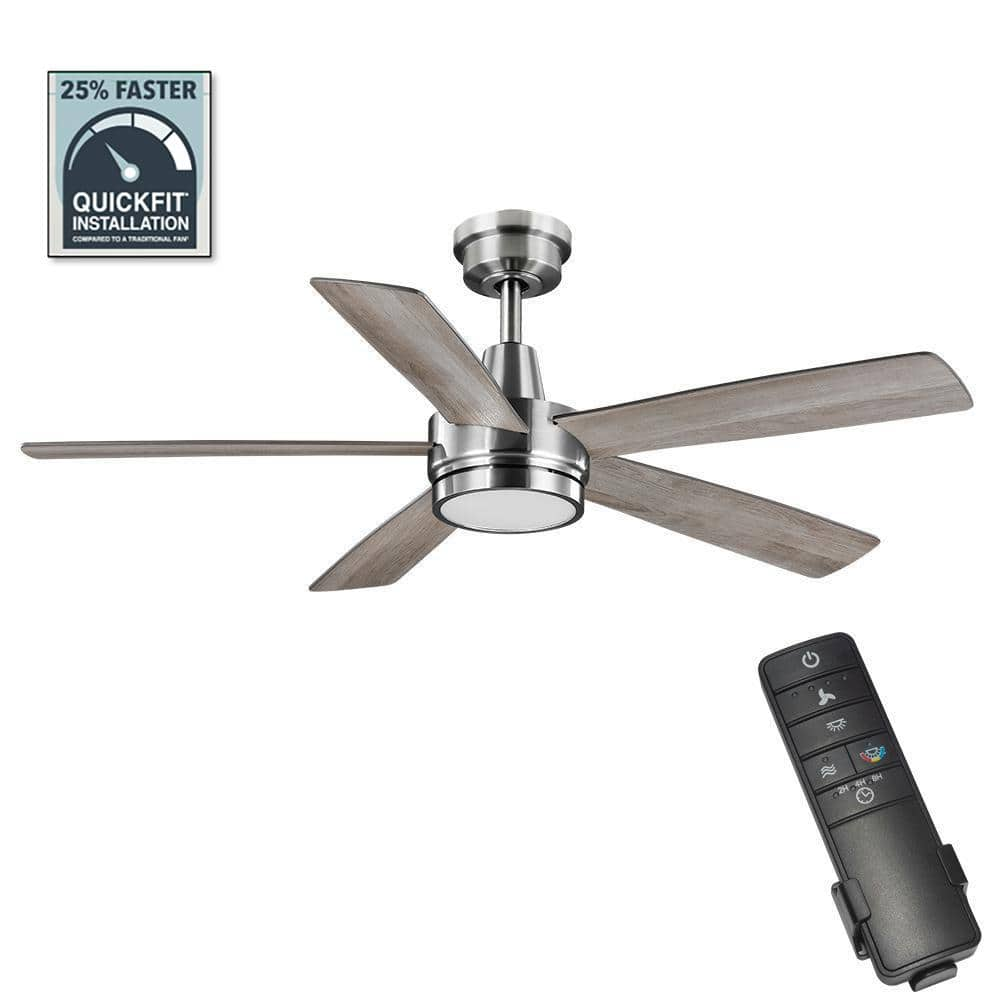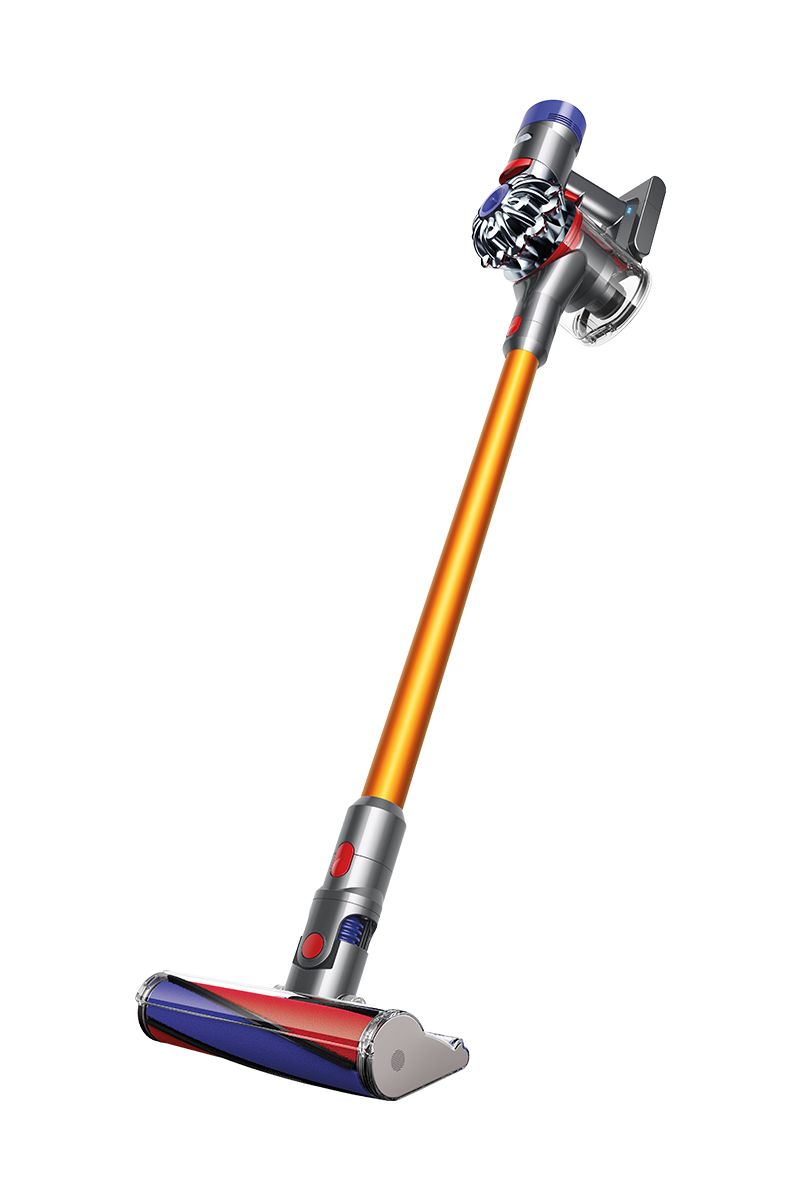Hampton Bay Fanelee 54 in. White Color Changing LED Brushed Nickel Smart Ceiling Fan with Light Kit and Remote Powered by Hubspace
Wireless control with Hubspace App, Google and Alexa. Maintenance-free integrated LED, no bulbs to replace. Choose from 6 color temperatures for the perfect shade of light.
The 54 in. Fanelee Smart Ceiling Fan from Hampton Bay is the perfect way to add a ceiling fan to your smart home ecosystem. This fan offers a variety of control options: remote control (included), control via your smart device (phone or tablet) with the HubSpace App, or voice control with Alexa or Google Assistant. The integrated 31-Watt LED offers ample lighting and the ability to choose from 6 different light temperature settings ranging from 2700K to 6500K. The beautiful brushed nickel finish is complemented with a frosted shatter resistant plastic shade that mimics frosted glass with the added benefit of not breaking if dropped during cleaning. Designed for indoor use in large rooms, the Fanelee features a quiet, yet powerful, 4-speed reversible motor for year-round comfort.
- Manage device with Hubspace, Google and Alexa; No Hub required
- Wireless control with your smart device, phone or remote control
- Smart ceiling fan compatible with Alexa and Google Assistant with no hubs or extra equipment necessary
- Control the fan with the included remote control, voice control, or free HubSpace app on your smart device (phone/tablet)
- HubSpace App and voice control allows control for fan speed, light control (on/off/dimming/color temperature), scheduling and timers
- Integrated, dimmable 31-Watt LED light allows you to choose from 6 different light temperature settings
- Light temperature options: 2700K, 3000K, 3500K, 4000K, 5000K, 6500K
- Dual mount installation (standard flat ceiling or angled mount) – Compatible with 3/4in Dia threaded extension downrods up to 48in in length (sold separately)
- Brushed nickel finish with 5 reversible blades in graywashed oak and dark oak finishes
- Frosted shatter resistant plastic shade that mimics frosted glass
- QuickFit Installation – installs 25% faster compared to traditional fans; Slide-on mounting bracket, twist and lock light shade
- Hand-held remote controls fan speed, light (on/off/dimming/color temperature), and comfort breeze mode (quick connect receiver plug for easy installation and wall cradle included)
- Quiet 4-speed reversible motor for year-round comfort
- Fan will operate as a standard remote control fan without Wi-Fi and Alexa or Google devices
Additional information
| Dimensions | H 15.90 in, W 54.00 in, D 54.00 in |
|---|---|
| Downrod Length (in.) | 6 |
| Fan Blade Length (In.) | 23.9 |
| Fan Blade Span (in.) | 54 |
| Fan Blade Width (In.) | 5.9 |
| Certifications and Listings | FCC Listed, FCC Listed, UL Listed |
| Manufacturer Warranty | Lifetime Motor Warranty |
54 may refer to:
- 54 (number)
- one of the years 54 BC, AD 54, 1954, 2054
- 54 (novel), a 2002 novel by Wu Ming
- Studio 54, a New York City nightclub from 1977 until 1981
- Fifty-Four (film), a 1998 American drama film about the club
- 54 (album), a 2010 album by Metropole Orkest
- "Fifty Four", a song by Karma to Burn from the album Arch Stanton, 2014
- 54th Division (disambiguation)
- 54th Regiment of Foot (disambiguation)
- 54th Infantry (disambiguation)
- 54 Alexandra, a main-belt asteroid
- Tatra 54, an automobile
A bay is a recessed, coastal body of water that directly connects to a larger main body of water, such as an ocean, a lake, or another bay. A large bay is usually called a gulf, sea, sound, or bight. A cove is a small, circular bay with a narrow entrance. A fjord is an elongated bay formed by glacial action. The term embayment is also used for related features, such as extinct bays or freshwater environments.
A bay can be the estuary of a river, such as the Chesapeake Bay, an estuary of the Susquehanna River. Bays may also be nested within each other; for example, James Bay is an arm of Hudson Bay in northeastern Canada. Some large bays, such as the Bay of Bengal and Hudson Bay, have varied marine geology.
The land surrounding a bay often reduces the strength of winds and blocks waves. Bays may have as wide a variety of shoreline characteristics as other shorelines. In some cases, bays have beaches, which "are usually characterized by a steep upper foreshore with a broad, flat fronting terrace". Bays were significant in the history of human settlement because they provided easy access to marine resources like fisheries. Later they were important in the development of sea trade as the safe anchorage they provide encouraged their selection as ports.
A ceiling is an overhead interior surface that covers the upper limits of a room. It is not generally considered a structural element, but a finished surface concealing the underside of the roof structure or the floor of a story above. Ceilings can be decorated to taste, and there are many examples of frescoes and artwork on ceilings, especially within religious buildings. A ceiling can also be the upper limit of a tunnel.
The most common type of ceiling is the dropped ceiling, which is suspended from structural elements above. Panels of drywall are fastened either directly to the ceiling joists or to a few layers of moisture-proof plywood which are then attached to the joists. Pipework or ducts can be run in the gap above the ceiling, and insulation and fireproofing material can be placed here. Alternatively, ceilings may be spray painted instead, leaving the pipework and ducts exposed but painted, and using spray foam.
A subset of the dropped ceiling is the suspended ceiling, wherein a network of aluminum struts, as opposed to drywall, are attached to the joists, forming a series of rectangular spaces. Individual pieces of cardboard are then placed inside the bottom of those spaces so that the outer side of the cardboard, interspersed with aluminum rails, is seen as the ceiling from below. This makes it relatively easy to repair the pipes and insulation behind the ceiling, since all that is necessary is to lift off the cardboard, rather than digging through the drywall and then replacing it.
Other types of ceiling include the cathedral ceiling, the concave or barrel-shaped ceiling, the stretched ceiling and the coffered ceiling. Coving often links the ceiling to the surrounding walls. Ceilings can play a part in reducing fire hazard, and a system is available for rating the fire resistance of dropped ceilings.
Color (American English) or colour (Commonwealth English) is the visual perception based on the electromagnetic spectrum. Though color is not an inherent property of matter, color perception is related to an object's light absorption, reflection, emission spectra and interference. For most humans, colors are perceived in the visible light spectrum with three types of cone cells (trichromacy). Other animals may have a different number of cone cell types or have eyes sensitive to different wavelength, such as bees that can distinguish ultraviolet, and thus have a different color sensitivity range. Animal perception of color originates from different light wavelength or spectral sensitivity in cone cell types, which is then processed by the brain.
Colors have perceived properties such as hue, colorfulness (saturation) and luminance. Colors can also be additively mixed (commonly used for actual light) or subtractively mixed (commonly used for materials). If the colors are mixed in the right proportions, because of metamerism, they may look the same as a single-wavelength light. For convenience, colors can be organized in a color space, which when being abstracted as a mathematical color model can assign each region of color with a corresponding set of numbers. As such, color spaces are an essential tool for color reproduction in print, photography, computer monitors and television. The most well-known color models are RGB, CMYK, YUV, HSL and HSV.
Because the perception of color is an important aspect of human life, different colors have been associated with emotions, activity, and nationality. Names of color regions in different cultures can have different, sometimes overlapping areas. In visual arts, color theory is used to govern the use of colors in an aesthetically pleasing and harmonious way. The theory of color includes the color complements; color balance; and classification of primary colors (traditionally red, yellow, blue), secondary colors (traditionally orange, green, purple) and tertiary colors. The study of colors in general is called color science.
Fan commonly refers to:
- Fan (machine), a machine for producing airflow, often used for cooling
- Hand fan, an implement held and waved by hand to move air for cooling
- Fan (person), short for fanatic; an enthusiast or supporter, especially with regard to entertainment
Fan, FAN or fans may also refer to:
Light, visible light, or visible radiation is electromagnetic radiation that can be perceived by the human eye. Visible light spans the visible spectrum and is usually defined as having wavelengths in the range of 400–700 nanometres (nm), corresponding to frequencies of 750–420 terahertz. The visible band sits adjacent to the infrared (with longer wavelengths and lower frequencies) and the ultraviolet (with shorter wavelengths and higher frequencies), called collectively optical radiation.
In physics, the term "light" may refer more broadly to electromagnetic radiation of any wavelength, whether visible or not. In this sense, gamma rays, X-rays, microwaves and radio waves are also light. The primary properties of light are intensity, propagation direction, frequency or wavelength spectrum, and polarization. Its speed in vacuum, 299792458 m/s, is one of the fundamental constants of nature. Like all types of electromagnetic radiation, visible light propagates by massless elementary particles called photons that represents the quanta of electromagnetic field, and can be analyzed as both waves and particles. The study of light, known as optics, is an important research area in modern physics.
The main source of natural light on Earth is the Sun. Historically, another important source of light for humans has been fire, from ancient campfires to modern kerosene lamps. With the development of electric lights and power systems, electric lighting has effectively replaced firelight.
Nickel is a chemical element; it has symbol Ni and atomic number 28. It is a silvery-white lustrous metal with a slight golden tinge. Nickel is a hard and ductile transition metal. Pure nickel is chemically reactive, but large pieces are slow to react with air under standard conditions because a passivation layer of nickel oxide forms on the surface that prevents further corrosion. Even so, pure native nickel is found in Earth's crust only in tiny amounts, usually in ultramafic rocks, and in the interiors of larger nickel–iron meteorites that were not exposed to oxygen when outside Earth's atmosphere.
Meteoric nickel is found in combination with iron, a reflection of the origin of those elements as major end products of supernova nucleosynthesis. An iron–nickel mixture is thought to compose Earth's outer and inner cores.
Use of nickel (as natural meteoric nickel–iron alloy) has been traced as far back as 3500 BCE. Nickel was first isolated and classified as an element in 1751 by Axel Fredrik Cronstedt, who initially mistook the ore for a copper mineral, in the cobalt mines of Los, Hälsingland, Sweden. The element's name comes from a mischievous sprite of German miner mythology, Nickel (similar to Old Nick). Nickel minerals were green, like copper ores, and were known as kupfernickel – Nickel's copper – because they produced no copper. An economically important source of nickel is the iron ore limonite, which is often 1–2% nickel. Other important nickel ore minerals include pentlandite and a mix of Ni-rich natural silicates known as garnierite. Major production sites include the Sudbury region, Canada (which is thought to be of meteoric origin), New Caledonia in the Pacific, and Norilsk, Russia.
Nickel is one of four elements (the others are iron, cobalt, and gadolinium) that are ferromagnetic at about room temperature. Alnico permanent magnets based partly on nickel are of intermediate strength between iron-based permanent magnets and rare-earth magnets. The metal is used chiefly in alloys and corrosion-resistant plating. About 68% of world production is used in stainless steel. A further 10% is used for nickel-based and copper-based alloys, 9% for plating, 7% for alloy steels, 3% in foundries, and 4% in other applications such as in rechargeable batteries, including those in electric vehicles (EVs). Nickel is widely used in coins, though nickel-plated objects sometimes provoke nickel allergy. As a compound, nickel has a number of niche chemical manufacturing uses, such as a catalyst for hydrogenation, cathodes for rechargeable batteries, pigments and metal surface treatments. Nickel is an essential nutrient for some microorganisms and plants that have enzymes with nickel as an active site.
White is the lightest color and is achromatic (having no hue). It is the color of objects such as snow, chalk, and milk, and is the opposite of black. White objects fully reflect and scatter all the visible wavelengths of light. White on television and computer screens is created by a mixture of red, blue, and green light. The color white can be given with white pigments, especially titanium dioxide.
In ancient Egypt and ancient Rome, priestesses wore white as a symbol of purity, and Romans wore white togas as symbols of citizenship. In the Middle Ages and Renaissance a white unicorn symbolized chastity, and a white lamb sacrifice and purity. It was the royal color of the kings of France, and of the monarchist movement that opposed the Bolsheviks during the Russian Civil War (1917–1922). Greek temples and Roman temples were faced with white marble, and beginning in the 18th century, with the advent of neoclassical architecture, white became the most common color of new churches, capitols and other government buildings, especially in the United States. It was also widely used in 20th century modern architecture as a symbol of modernity and simplicity.
According to surveys in Europe and the United States, white is the color most often associated with perfection, the good, honesty, cleanliness, the beginning, the new, neutrality, and exactitude. White is an important color for almost all world religions. The pope, the head of the Roman Catholic Church, has worn white since 1566, as a symbol of purity and sacrifice. In Islam, and in the Shinto religion of Japan, it is worn by pilgrims. In Western cultures and in Japan, white is the most common color for wedding dresses, symbolizing purity and virginity. In many Asian cultures, white is also the color of mourning.
With or WITH may refer to:
- With, a preposition in English
- Carl Johannes With (1877–1923), Danish doctor and arachnologist
- With (character), a character in D. N. Angel
- With (novel), a novel by Donald Harrington
- With (album), a 2014 album by TVXQ
- With (EP), a 2021 EP by Nam Woo-hyun






by Cristian
I love this thing! It was easy to install and it works very well. With the Hubb Space app I can turn the light and/or fan on, change the color of the light (we chose a light that only has white colors, but they range from warm to cool and it’s nice to have choices) and/or dim the light. The fan moves a lot of air, has 3 settings and all are quiet. I highly recommend.
by Srini
We bought 2 of this models and they are awesome. They are much faster then couple of brands we used.
by Ruth
I really love the smart function more than I thought I would. You can have Alexa turn the fan off and on, higher and lower. I am not a fan of having another remote control to lose around the house, but having Alexa control it just by my voice is great!
by Brat
Great fan for my livingroom.
by Nola
Comfort setting randomly changes speed to simulate a true breeze.